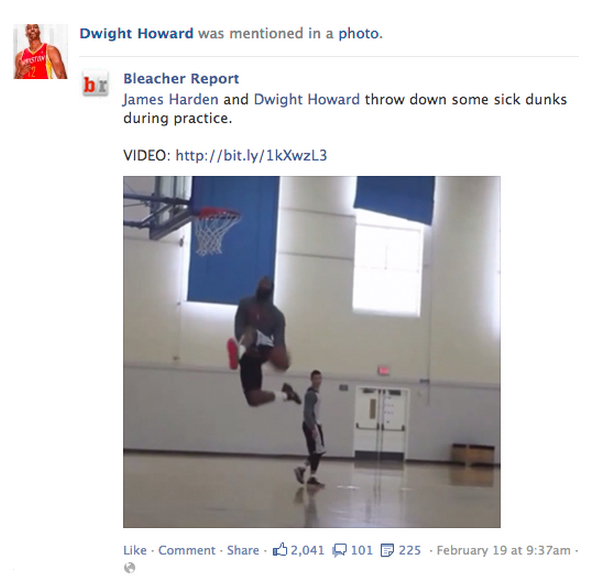How Facebook’s News Feed Now Lets Brands Ride The Coattails Of Other Brands
Facebook has announced a change today that means users will begin seeing posts about Facebook pages they follow, even if those posts are made by pages they do not follow. It all comes down to Facebook tagging, and it’s a way that one brand can extend its audience with a tagged shoutout to another brand. […]
Facebook has announced a change today that means users will begin seeing posts about Facebook pages they follow, even if those posts are made by pages they do not follow. It all comes down to Facebook tagging, and it’s a way that one brand can extend its audience with a tagged shoutout to another brand.
Consider this example that Facebook has shared, of how the new system works:

In this example, the Facebook user follows Houston Rockets basketball player Dwight Howard’s Facebook page. That means they see some of the updates from Howard’s page, ones that Facebook’s news feed algorithm decides are relevant to show.
Now look here, a close up of that post:

The post the Dwight Howard follower is being shown doesn’t actually come from Dwight Howard. Instead, it’s from the Bleacher Report’s Facebook page (as the top arrow points to). Because the Bleacher Report “tagged” Dwight Howard in its post — made a Facebook link to the Dwight Howard page, as the lower arrow points to, Facebook’s new system now considers it relevant to anyone who follows the Dwight Howard page.
In short, any post from one brand that tags that page of another brand (be it a person, company, service or anything with a Facebook page) effectively gets a shot at tapping into that brand’s Facebook followers.
It’s not a free-for-all. Facebook says it will look to see how closely the audiences of both pages seem to be, when deciding whether to extend one brand’s reach to another’s followers:
We look at many factors to make sure the most relevant stories appear in News Feed, including which posts are getting the most engagement (such as likes, comments, shares and clicks) across all of Facebook. We also consider which posts are getting the most engagement from people who like both the Page that posted and the Page that was tagged.
For example, if many people who like Dwight Howard also like the Bleacher Report, it suggests that these two Pages are connected. If we see that people who like both the Bleacher Report and Dwight Howard are liking the post above, that’s an indication that it may be relevant for people who only like Dwight Howard.
As marketers, this is a great reminder to take the time and properly tag other pages as there may be extra visibility coming your way. For more information on Facebook tagging, see its help page here. And for more about the change, see the official release from Facebook.
Contributing authors are invited to create content for MarTech and are chosen for their expertise and contribution to the martech community. Our contributors work under the oversight of the editorial staff and contributions are checked for quality and relevance to our readers. MarTech is owned by Semrush. Contributor was not asked to make any direct or indirect mentions of Semrush. The opinions they express are their own.
Related stories